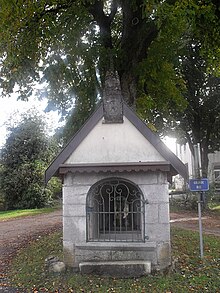Fade
| Fade | ||
|---|---|---|
|
|
||
| region | Bourgogne-Franche-Comté | |
| Department | Doubs | |
| Arrondissement | Besançon | |
| Canton | Baume-les-Dames | |
| Community association | Doubs Baumois | |
| Coordinates | 47 ° 25 ' N , 6 ° 23' E | |
| height | 413-462 m | |
| surface | 5.18 km 2 | |
| Residents | 108 (January 1, 2017) | |
| Population density | 21 inhabitants / km 2 | |
| Post Code | 25110 | |
| INSEE code | 25602 | |
Vergranne is a French municipality with 108 inhabitants (as of January 1 2017) in Doubs in the region Bourgogne Franche-Comté .
geography
Vergranne is located at 450 m , seven kilometers north-northeast of Baume-les-Dames and about 34 kilometers northeast of the city of Besançon (as the crow flies). The village extends on a hill on the high plateau between the river valleys of Doubs in the south and Ognon in the north.
The area of the 5.18 km² municipal area covers a section of the gently undulating landscape north of the Doubs. The entire area is occupied by a high plateau, which is an average of 440 m. It shows a loose structure of arable and meadow land or forest. The plateau slopes slightly towards the west. There are no above-ground rivers in the entire area because the rainwater seeps into the karstified subsoil. At 462 m, the highest point of Vergranne is reached on a hill southwest of the village. To the north, the municipality extends to the edge of the Bois des Brosses , to the east to the Bois de Reuge and to the south to the Les Mondrevaux corridor .
Neighboring municipalities of Vergranne are Mésandans in the north, Viéthorey and Voillans in the east, Autechaux in the south and Verne and Rillans in the west.
history
In addition to other finds from the Quaternary period, a human tooth that is around 400,000 years old was discovered on the parish of Vergranne . In the Middle Ages, Vergranne belonged to the domain of Clerval , which had been under the sovereignty of the Counts of Montbéliard since the 14th century. Together with Franche-Comté , the village finally came to France with the Peace of Nijmegen in 1678. Today Vergranne is part of the Doubs Baumois municipal association .
Attractions
The Vergranne chapel was built in 1777.
population
| Population development | |
|---|---|
| year | Residents |
| 1962 | 80 |
| 1968 | 82 |
| 1975 | 60 |
| 1982 | 71 |
| 1990 | 77 |
| 1999 | 98 |
| 2005 | 113 |
| 2016 | 109 |
With 108 inhabitants (as of January 1, 2017), Vergranne is one of the smallest municipalities in the Doubs department. After the population had decreased significantly in the first half of the 20th century (140 people were still counted in 1901), the population has continued to grow steadily since the mid-1970s. Since then the population has almost doubled.
Economy and Infrastructure
Vergranne was a village dominated by agriculture (arable farming, fruit growing and cattle breeding) and forestry until well into the 20th century. Even today, the residents live mainly from their work in the first sector. Outside the primary sector there are few jobs in the village. Some workers are also commuters who work in the surrounding larger towns.
The village is located off the main thoroughfares on a departmental road that leads from Autechaux to Fontenelle-Montby. The closest connection to the A36 motorway is around five kilometers away. Another road connection exists with Verne.

